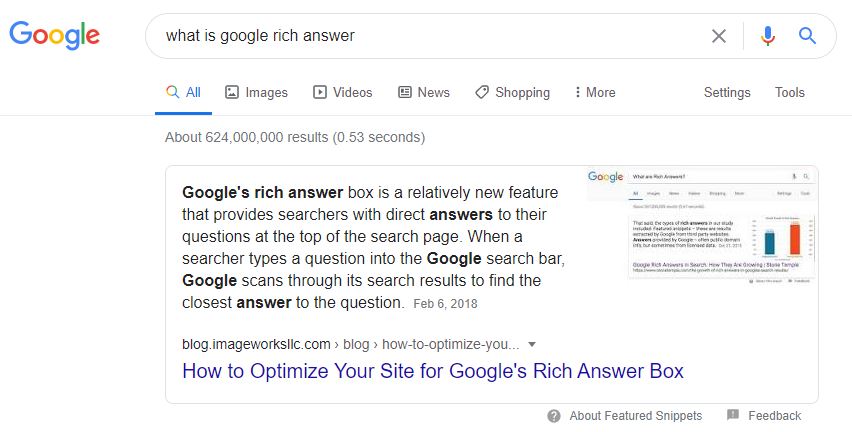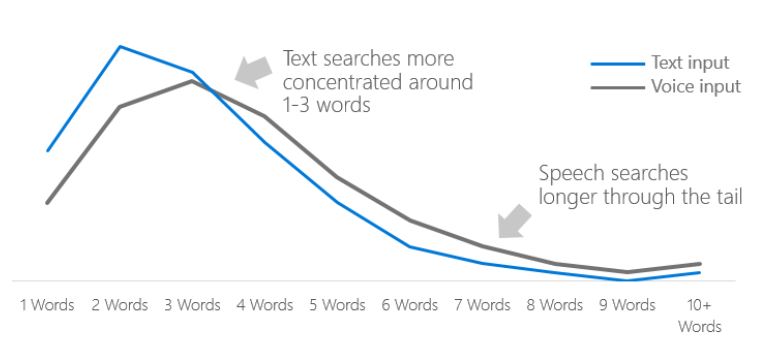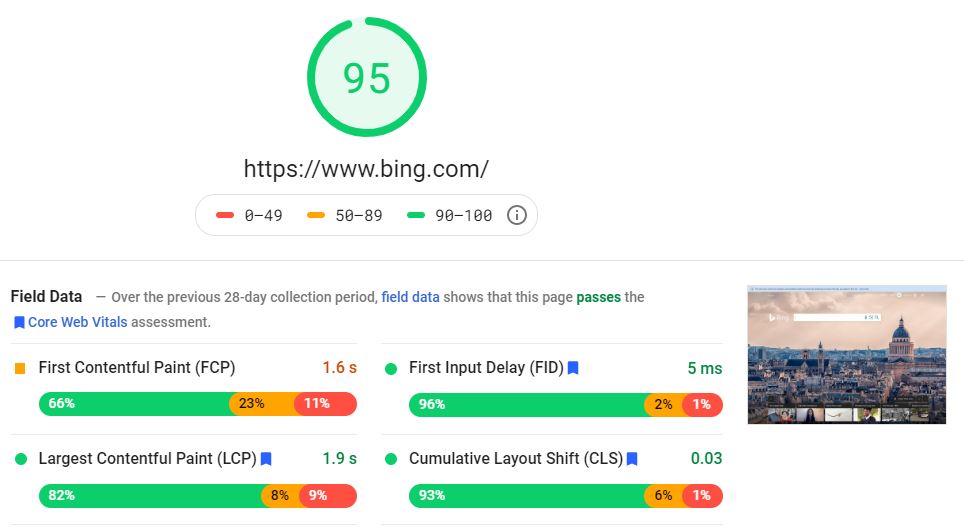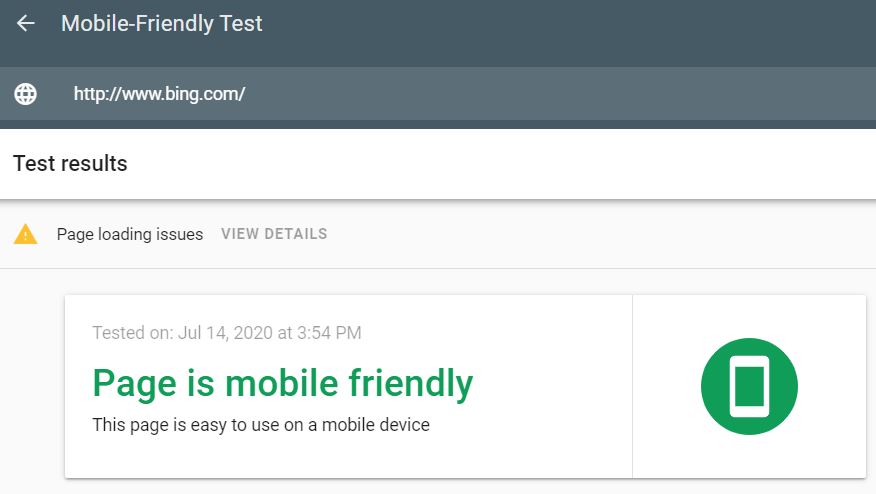In the first part of our how to optimize for voice search journey, we covered how voice search is different from traditional search, and in the second part, we learned how to do keyword research for voice search. In this final part of our voice search journey, we cover optimizing your content and site for voice search.
7 Ways to Optimize Content For Voice Search
Here is how to optimize your content for voice search:
1. Optimize content for Rich Answers
According to a voice search study from SEMrush, “70% of answers got from voice queries have a SERP feature.
Most smart devices with voice search features will have a similar answer to a particular question, and in most cases, the answers are the rich answers for the question.
We need to familiarize ourselves with some SEO terms in order to understand the whole concept better.
Knowledge Graph
The Knowledge Graph is an important part of the search experience in Google. It’s all that information you see on the right side of the search results (when they aren’t blank with nothing there). Getting your information in there is of the essence, especially if you have a business. Here’s a knowledge graph of Albert Einstein.
Knowledge Panel
Knowledge panels are information boxes that appear on the right side of the Google search results when you search for entities (people, places, organizations, things) that are in the Knowledge Graph (see above). They are meant to help you get a snapshot of information on a topic based on Google’s understanding of available content on the web.
Featured snippet
Featured snippets are special boxes where the format of regular listings is reversed, showing the descriptive snippet first and the URL below:
Rich Answer
A search result that contains any of these features is called a rich answer. A rich answer is Google’s attempt to provide quick, accurate answers to searchers’ queries without requiring them to click through to a website staying on the Google site for longer. Rich answers come in many forms, such as recipes, sports scores, stock graphs, calculators, sliders, text-based answers, step-by-step directions, maps, and more.
2. Analyze and Restructure Your Content
As mentioned earlier, voice search is more conversational than regular searches. So you need to re-imagine and restructure your content.
What you should work towards is to add brief and to-the-point questions and answers to enhance the content layout and improve its voice search feature.
Google is more interested in quick, concise answers to voice search questions.
A recent Google Assistant study discovered that “text length of the answers returned was around 41 words- almost similar for all devices”.
All these are critical insights about how we should structure our content for better ranking on voice search results. Two more quick tips:
- Add FAQ sections, make sure they have question keywords, and keep them short too. Using the FAQ-style format will allow Google to easily pull out your website content and rank it as a rich snippet.
- Another best practice to help rank your website for voice search is to use pointers to break down your web content into small sections.
3. Use Conversational Language
Being conversational is one of the key features of voice search, and you should utilize this in your content development.
Answering the following questions with data-driven insight will give you an idea of what users want when they do a voice search:
- What kind of question keywords do people use?
- What’s their conversational style?
- What question do people frequently ask?
- What type of answers best suits these queries?
- What are the best answers that frequently pop up on voice search results?
4. Go for Long-Tail Keywords
As mentioned in our keyword article (and the image above) you don’t want to just load up on keywords. Voice search phrases are longer because they are more conversational, but you can’t create content separately for individual voice search terms.
What you can do is create long-form content that includes all the long-tail keywords you want with filler words. These additional filler words ultimately perform well in voice search ranking.
Some filler word examples:
5. Improve your Website Loading Time
While this is an important factor for voice search success, many times, this factor isn’t always optimized well, but just because people forget about it does not reduce its importance.
Slow-loading websites are always abandoned, unlike those with quick load time. Not sure how fast your website is? Check out this free tool.
Here is a quick list of the dos and don’ts for website loading speeds:
- Always compress your website images and videos
- Always use HTML and CSS3 frameworks because they are known to load web pages faster
- Reduce HTTP requests
- Reduce the number of plugins on your site
- Give Content Delivery Network (CDN) a try
Above all, slow page loading speed plays a critical role in your website’s conversion rate and bounce rate. If the page takes forever to load, people won’t stick around.
6. Do not overlook the value of mobile
Larger parts of the announcement at Google I/O 2019 were either on mobile or directly related to its tools. Google emphasized the mobile experience and promised to improve on it every day.
When it comes to voice search, mobile beats every other device, because the majority of voice search is done on mobile. Get your website optimized for a better mobile user experience.
The key is creating mobile-friendly content and taking a mobile-first approach. Here’s a quick checklist of what to pay attention to:
- Create a mobile-friendly website
- Run a test for your site to check if it’s mobile-friendly
- Your website must be easy to navigate to increase exposure and visibility to your content.
Mobile remains the future of search, and vocal queries are not left out. Creating or optimizing a website for mobile is an SEO practice that should be taken seriously.
7. Utilize Google My Business Listings
As mentioned earlier, many people use voice queries for “near me” searches. Your Google My Business Listing will determine whether or not you rank for these searches.
Google My Business Listing is a way of informing Google of the location of a particular business. When people ask Google to list out businesses in that area, your website could pop up for the search.
You must include the Name, Address, and Phone number of your business in the listing. Also, selecting the right categories and adding the correct area code is crucial. You can make your business stand out by adding posts with news or exclusive updates.
So if you’re yet to have a Google My Business Listing, now is the perfect time to do so. Give this a try, and you will be amazed by the positive results.
Targeting local keywords and gaining more search ranking is another valuable way of ranking for near me searches.
Extra tip:
Bonus: Improve Overall Readability
Writing a sharp, crisp, and readable content is an important factor that we somehow overlook. Concise and high-quality writing is one of the factors considered for website ranking. Avoid tech jargon and use simple, natural words.
The Ball Is In Your Court
Tech giants like Microsoft, Amazon, and Google have already had their sites optimized for voice search giving them an edge over others. Your content has to be optimized for voice search to stay ahead.
The strategies listed above will help your website rank higher for voice search. Need more help? Get in touch!
About The Author
Marketing Team
The AOK Marketing Team is a diverse group of amazing individuals driven to help all of our clients succeed. Great people are everywhere, and we believe that people should control their workday, their work environment, and where they live. We have team members in 9 countries: United States, Canada, Egypt, Belgium, Ireland, Australia, India, Pakistan, and Hong Kong.
How can we help you?












